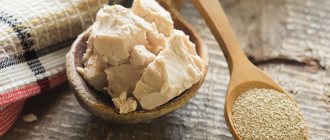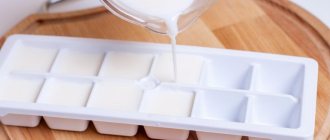In cooking, live yeast is most often added to dough to make baked goods fluffy and soft. Some types allow you to prepare beer, wine and other alcoholic beverages. But what if you haven’t used up all the yeast during the cooking process? After all, it is known that at room temperature after opening the package they are stored for no longer than a day. Can the product be frozen?
At subzero temperatures, baking fungi enter a state of suspended animation, that is, sleep, during which metabolism slows down. After thawing, they completely retain their properties, so yeast can be frozen. But this process has its own subtleties.
Why are Easter cakes placed on their side?
When a freshly baked Easter cake is removed from the oven, it is often placed on its side and turned over after 15 - 20 minutes so that it cools evenly on all sides; this is necessary to protect it from shrinkage and subsidence.
Interesting materials:
Why do guys like to hug their waist? Why does your face change before your period? Why can't you treat wounds with peroxide? Why is recycling important today? Why is the planet Venus so named? Why does the tachometer needle float? Why does bread float? Why is the sky red at night? Why does moss appear on the lawn? Why does air appear in the cooling system?
Physical properties of yeast
Yeasts are the simplest single-celled fungi. There are more than 1,500 species of them in the world. Some (pressed bakery, beer) benefit humans, others (candida genus) are opportunistic and can cause disease.
As far back as ancient Egypt, people used live yeast to ferment foods, bake and brew beer. But only in the 19th century did scientists realize that these were not just chemical compounds, but microorganisms capable of growth and reproduction.
Nowadays, compressed baker's yeast is most often used in households. For normal life they require the following conditions:
- Availability of oxygen. You should only store the product in packaging that "breathes". For example, in paper.
- Slightly acidic environment. The normal pH value is 4.5–5. During long-term storage in an alkaline environment (for example, in salt), yeast cells are inhibited.
- Optimal temperature. Most types of yeast, including baking yeast, cannot withstand 45–50 degrees. Therefore, there are no living microorganisms in finished baked goods, as authors in some media like to scare. But low temperatures are not a problem for yeast. The ideal option for fresh pressed ones is storage in the refrigerator.
We recommend: 9 ways to check cheese for naturalness at home
So is it possible to freeze a “live” product? Yes. But only in compliance with the rules described below.
How to quickly defrost pizza dough?
Dough for unleavened pies and pizza can be defrosted in a water bath.
How to quickly defrost pizza dough:
- For these purposes, you need to place the dough in a pan, after placing several paper towels on the bottom.
- Place a lump of dough wrapped in plastic on top. The container is immersed in a bowl of boiling water and placed on low heat.
- From time to time, it is necessary to turn the dough over so that the upper layers that come into contact with the walls of the vessel do not overheat.
For pies
How long can you store
Different yeasts have their own shelf life. You can see it on the package. If there is no packaging left, check out the approximate shelf life of the products:
- Pressed briquettes can be stored frozen for up to 2 years.
- It doesn’t always make sense to put dry ones in the refrigerator or freezer; they hold up well in room conditions. It is wise to save the product if the packaging has been opened. If you decide to store supplies for the future, try to remove and use the product within 2 weeks if it was in the refrigerator, and within 6 months if it was in the freezer.
Tip from Miss Clean: Always test your yeast before adding it to your dough to avoid wasting your ingredients. Take 1 tsp. defrosted yeast, add warm water or milk (temperature - 30 degrees), a little flour and sugar. Place the plate in a warm place. If after 10-15 minutes bubbles appear on the surface, the microorganisms are working and can be used for baking.
By the way, it is better to remove the top darkened layer from the compressed yeast briquette.
Important Terms
- Oxygen Yeast feeds on sugars, and in the process of life, it consumes oxygen and releases carbon dioxide, the bubbles of which “get stuck” in the gluten of the dough, making the bread porous and fluffy.
© Depositphotos
For yeast to breathe, it must be stored in a package that does not impede air access. For example, in paper. - Acidity The normal pH value for yeast is in the range of 4.5–5. Long-term storage in an alkaline environment (for example, salt) inhibits yeast cells.
- Temperature The most favorable temperature for yeast propagation is 25–28 degrees. Alcoholic fermentation is most active at a temperature of 30–35 degrees.
© DepositphotosAt temperatures of 45–50 degrees and above, yeast cells die.
How to freeze yeast?
Fresh baker's compressed yeast is stored the least. In the refrigerator - no longer than 2 weeks. However, such a product has a number of advantages. Compared to dry and granulated mushrooms, it makes the finished baked goods more fluffy. In addition, it contains a maximum of vitamins.
How to properly freeze compressed baker's yeast?
- Check the freshness of the product. There is no point in freezing spoiled mushrooms. A truly “living” product has a delicate creamy color and a slightly sour smell. When pressed, the block easily crumbles.
- Prepare portions. You should not put a large bar in the freezer, because most likely you will not be able to use it at one time. But microorganisms cannot be re-frozen: this will cause them to lose their properties. It is better to cut the block into pieces of 50–100 g.
- Start packaging. Yeast can be packed in parchment or plastic bags. Plain paper will not work because it will get wet when defrosting. Write the date of freezing on the packages with a marker.
The product can be stored in the freezer for no more than 1 year.
What happens if you defrost yeast dough in the microwave?
It is better not to defrost yeast dough in the microwave. It is believed that yeast loses its properties with this method of thawing. But if such a need arises, then put the dough in the oven for no more than a minute, otherwise the top layer of the product will dry out.
Interesting materials:
What does a heel person mean? What does it mean that a person is not indifferent? What does it mean to be a person with signs of degeneration? What does a draft application for public services mean? What does black stool mean in an adult? What does the black heart emoji mean? What does Chsv mean in tik tok? What does Ctrl Shift Del mean? What does it mean to delegate a person? What does it mean to delegate a form?
How long does dry yeast from the store last?
The lower the moisture content of a store-bought product, the longer it will last in a sealed package. Thus, instant yeast (40%) can be kept in a dry, dark place for up to 6 weeks. Active (9%) remain viable at room temperature for 6 months, and instant (3–4%) - 2 years.
What if the package was opened? Then you have two options for storing dry yeast, regardless of its type:
- in the refrigerator – up to 1 month;
- in the freezer – up to 1 year.
In the second case, it is recommended to package the product in fabric bags or plastic bags. The rules for defrosting are the same as in the case of pressed mushrooms.
So, yeast likes low temperatures more than high ones. Therefore, you can safely store them in the refrigerator or freeze them. It is better to prepare the dried product yourself from fresh bars, since in the store you risk buying dead fungi in the form of powder or granules. Before adding yeast to the dough, be sure to check its viability.
Can brewer's yeast be frozen?
It is not recommended to freeze brewer's yeast, as low temperatures make it unsuitable for its intended use. Wine and alcohol yeasts cannot be stored in the refrigerator.
Interesting materials:
How so immediately? How to cut Eustoma? How to cut wallpaper in a corner? How to cut parsley for the winter? How to sew a stem seam? How to stabilize spruce branches? How to start in biathlon? How to become more feminine and gentle? How to become the boss of a GTA 5 motorcycle club? How to register with a narcologist?
Self-freezing
After cooking the dish, there may be excess dough left. To avoid throwing it away, it is frozen at home. For example, this can be done in the freezer. There the product will not lose its beneficial and nutritional qualities. You can freeze not only the dough, but also dishes made from it, for example, pies, pies, bread, dumplings, manti. Finished products are stored frozen for a very long time, up to 2 months. If necessary, you can take them out of the freezer and quickly prepare lunch or dinner.
To preserve the quality of the dough, it must be frozen correctly. To do this, it is rolled into a thin sausage and chopped into small pieces. Finished parts are wrapped in a plastic bag or cling film
An important rule: moisture should not get into the packaging before freezing, otherwise it will negatively affect the quality of the product.
What temperature can heat-resistant glue withstand? The power of a horseshoe: how to hang it above the door in the house Options for proper storage of shoes at home
The dough is then placed in the freezer. It sets the minimum temperature. This is necessary for the product to set quickly. When 2 weeks have passed, the temperature can be lowered by 3 degrees. In order for the product to be stored correctly when frozen, the following rules must be observed:
- The yeast dough is laid in this way: the separated pieces are placed at a distance of 3 cm from each other. Over time, the yeast composition increases, but maintaining a distance between the parts will prevent them from sticking together.
- Any type of dough can be stored in the freezer for no more than 4 months. After this, the product dries out and loses its beneficial properties and adhesiveness.
- Once a frozen product has been used, it should not be re-frozen. The remaining pieces are discarded.
- There is a way to freeze in foil: the dough is chopped into pieces, each sprinkled with flour. Then the total mass is gently kneaded until the surface becomes matte. The field of this composition is wrapped in foil. Do not allow air or moisture to enter.
When it becomes soft up to the middle (you can check this by gently poking it with your finger), the dough needs to be kneaded again and used.
Yeast dough is a very delicate thing, and not everyone can prepare it well. Therefore, some people buy it already frozen and the question arises of how to properly defrost yeast dough. It happens that there is a lot of dough and unused yeast dough can be frozen and used at the right time.
How to defrost yeast dough correctly?
There are several ways to defrost yeast dough, but the most correct ones that preserve all the properties of yeast require time:
What is the shelf life of fresh yeast?
It is known that the shelf life of compressed yeast in the refrigerator is only 12 days. But dry active yeast has a shelf life of about six months. It should also be noted that the shelf life of instant yeast is as much as five years.
Interesting materials:
How to water coniferous trees? How to water a bay tree? How to water young fruit tree seedlings? How to water fruit trees? How to water planted trees? How to water fruit tree seedlings after planting? How to fell a tree in the right direction? How to whiten trees in the garden correctly? How to whiten trees correctly? How to color trees correctly?
How to dry yeast?
In addition to freezing, you can dry fresh compressed mushrooms to extend shelf life:
- Crumble the block.
- Add a small amount of flour to the mixture and mix.
- Line a baking sheet with parchment paper and sprinkle the yeast on it.
- Leave the crumbs to dry in a well-ventilated area at room temperature.
- When the mushrooms are well dry, pour them into a glass jar. Cover the neck with paper or cotton cloth and tie it with a string.
We recommend: How can you dry hawthorn for the winter at home?
The product can be stored for up to 6 months in a dark, dry place. In the refrigerator - about a year.
LiveInternetLiveInternet
Which yeast is better to use for baking pizza - pressed or dry?
Any type of yeast, both pressed and dry, is suitable for baking pizza.
There are certain features of using both of them: - pressed yeast must be stored in the refrigerator at a temperature of +4º/6º C, shelf life is 35 days; dry ones can be stored at room temperature, but it is advisable to use opened packs on the same day, or, seal them tightly, store them at +4C for a week; — the ratio of replacement of pressed yeast to dry yeast is 3:1; — instant yeast is “afraid” of contact with ice water and ice, so when kneading cold dough, it should be added closer to the end of the kneading, when all the ice has melted; the temperature of the mass will be higher than +12ºС, or at the beginning of kneading, after mixing with a small amount of warm water +32º/35ºС until the consistency of thick sour cream. For baking regular wheat bread, is deactivated yeast used as an additive along with regular dry or compressed yeast or as an independent element for rising dough?
Dry deactivated yeast is a special improver for weakening gluten, designed to work with flour with short-tearing gluten, to maintain the shape given to dough pieces during proofing and baking, so they do not affect the formation of yeast in any way.
Is it possible to freeze compressed yeast?
Undesirable, because
static cold, or rather ice crystals, deforms the yeast cells and this negatively affects the lifting force of the yeast. I bought frozen yeast in a store, what should I do and how to check if it is suitable for use?
Pre-defrost them - put them in a regular refrigerator (+4C), they will thaw in a few hours.
And then try to bake something - this is the only way to test it at home. You can activate them - add them to warm water (+35º/37ºС), add a little flour and sugar, and leave for 5 minutes, stir. After 5-6 minutes, a “yeast cap” should appear - the first sign that the yeast is active. What is the difference between baker's yeast and top-fermenting brewer's yeast - is it all "Saccharomyces cerevisiae" yeast?
Yes, these are the same type of yeast, but the strains are different.
Does baker's yeast contain gluten?
Yeast, although baker's yeast, does not contain gluten, and no flour is used during its cultivation and growth.
The main substrate as a source of sugars and minerals is molasses. Gluten is the swollen protein in wheat flour (gliadin and glutenin). Do you need to mix the yeast with the flour first and only then do the rest?
At first I messed up a lot by dissolving them directly in milk without flour. If we are talking about dry active yeast, then you must first dilute it in warm water (+32º/35ºС) before adding it to the flour. If it is dry instant yeast, then it can be added either directly to the flour or diluted in water/milk for better distribution over the dough (kneading). Perhaps you dissolved the yeast in hot, or vice versa, very cold milk, so fermentation did not take place. Yeast is living organisms, they are very sensitive to temperature. The optimum of their vital activity is + 35º/38ºС. Exactly at this temperature, when they enter the substrate, they release the largest amount of carbon dioxide, which loosens the dough and forms the crumb of the product. The
composition of dry yeast may include sorbiat monostearate. Is it of animal or plant origin and what is the volume of this emulsifier in the yeast? A
natural source of stearic acid from by which monosorbitan stearate is synthesized - these are both vegetable oils and animal fats. By weight, it is much less than 1/60.
Will dry yeast lose its properties in an open packet?
An open pack, if stored at +4ºС (preferably hermetically sealed), can be triggered within 2/3 days, at +18ºС - within 7/10 days.
Otherwise, you will notice a significant decrease in the gas-forming ability of the yeast. In a home bread machine, which is better to use instant or active yeast?
Active dry yeast must be dissolved in warm water (+32º/35º C) before being added to the batch.
Dry instant yeast can be used directly in flour without dilution. The approximate ratio of dry active to dry instant is 1:1. It is advisable to use an open package of instant yeast within 1 day, or a hermetically sealed package with storage at +4ºС for a week. If an open packet is stored at +18ºС, it can be used within 2/3 weeks, but most likely you will feel a decrease in yeast activity. Therefore, at home it is easier and more convenient to work with dry instant yeast. What is the difference between special yeast for pizza?
Can pizza yeast be used to make kvass? Pizza yeast uses a special strain of baker's yeast with a high content of glutathione (a substance that acts as a reducing agent on the gluten framework, which ensures ease of rolling the dough piece into a layer and maintaining a uniform shape after proofing and baking).
In principle, you can try them for making kvass if the aroma does not bother you. Which yeast strains have more “live” strains - instant or active?
They are all alive.
If you bake bread with kefir, can it negatively affect the functioning of the yeast?
A live beer or kvass? To inhibit the work of yeast, you need to create very strong acidity.
Nothing bad will happen when adding kefir, just like when adding beer and kvass. You can safely use the usual dosages of yeast. What is the best dry/pressed yeast for pan bread?
Both dry and compressed yeast are equally good for pan bread.
Why do you need to pour dry yeast into the bread machine first and sprinkle with flour so that the yeast does not come into contact with water?
There really is no point if you are not going to use ice water or ice.
Dry yeast is “afraid” of low temperatures (it is advisable to use water at least +15C). Is yeast able to show its activity when storing partially baked products under normal conditions?
When the partial baking process is carried out correctly (regardless of whether it is classic or “express”), the temperature in the center of the half-baked product reaches +95º/97ºС, as in the fully baked product.
Because yeast cells completely die (denature) at +60º/65ºС, then even in partially baked products the yeast dies completely. The bread did not rise... I took milk from the refrigerator.
All instant yeast have a small disadvantage - such yeast are afraid of direct contact with cold water, in this case milk.
The fact is that during the manufacturing process, this yeast experiences drying “stress” (exposure to high temperatures). When yeast comes into contact with cold liquids, its gas-forming ability decreases, so the bread did not rise and did not turn out fluffy as you expected. Next time before adding milk, warm it up a little, to a maximum of +35C. I am very concerned about the topic of using GMOs in yeast production.
All yeast strains currently used in the production of all types of yeast, both dry and compressed, are in no way genetically modified organisms.
What are osmotolerant yeasts, how do they work, what is their mechanism?
Osmotolerant yeast (or otherwise sugar-tolerant), unlike ordinary strains of highly active yeast, have a smaller amount of the enzyme invertase in the cell wall.
As a result, sugar from the external environment enters the cell gradually and the yeast cell slowly “processes” it. At the same time, the yeast does not experience the “stress” of high osmotic pressure, like ordinary yeast, and does not lose the ability to normal metabolism, release a sufficient amount of carbon dioxide and the fermentation process of the dough does not slow down. When calculating water, you need to know the moisture content of dry yeast.
The humidity of dry yeast is 7% -8%.
They practically do not play a role in the calculation. Is it possible to remove the buoyancy of the dough by simply increasing the amount of yeast?
The reasons for “floatiness” can be different, ranging from the quality of the flour (poor quality/quantity of gluten, excessive enzyme content, perhaps even protease, which negatively affects the gluten framework), as well as from the quality of the yeast.
If the yeast is of unsatisfactory quality (old or stored in incorrect conditions), then increasing its dosage can cause even greater stickiness and spreadability of the dough (due to the high content of dead yeast cells and the presence of glutathione). You can adjust the quality of flour by adding an improver. Before using deactivated yeast, you need to know for sure that flour has short-tearing gluten?
Or will they perform well with normal flour? If you are working with normal quality wheat flour, but you are not satisfied with the plastic properties of the dough made from this flour, i.e., for example, when making pizza or yeast-free puff pastry, the workpieces shrink and do not hold their shape well (instead of a circle you get an oval), then you can add a minimum or an average dosage of deactivated yeast (0.06-0.1% by weight of flour).
If you see problems even on ordinary products, the products tear strongly during proofing, and shrink during baking towards the end - then most likely you have flour with short-tearing gluten. The dosage of regular yeast when used together with deactivated yeast does not change. I want to switch from using pressed yeast to instant yeast.
Please tell me, will this improve the taste and aroma characteristics of the products? When using instant yeast, you should take into account its features: - instant yeast “does not like” contact with ice and ice water, unlike pressed yeast.
— with a short batch, it is better to rehydrate the instant (dilute in water), otherwise the yeast vermicelli will not have time to dissolve. The replacement will not affect the taste, because you are pitching the same amount of yeast (difference in humidity, same strain). Substitution is justified if you want to save on storage space and refrigerator. Which pressed yeast is best for fermenting sugar wort?
Who has osmocharacter.
How to increase the shelf life of croissants to 30 days.
To prolong the freshness of croissants (as well as other cotton products), you need to “act” in two directions: - prolongation of softness and prolongation of microbiological purity.
From the point of view of “microbiology”: - increasing the acidity of the dough (using starters, you can try a ready-made starter or a starter for breeding a natural starter); - the use of preservatives (for croissants it is advisable to provide protection against mold and wild yeast - calcium propianate, sorbic acid); - replacing part of the sugar with dextrose (to increase osmotic pressure); From the point of view of softness: - adding glucose syrup (with recalculation of the total sweetness); — adding an improver for softness; - adding powdered milk (lactose is not fermented by yeast and actively participates in the Maillard reaction, which allows products to be baked less, dried out less, and products are softer). And of course, it is very important to set the “correct” baking parameters - high setting, then lowering and shortening the baking duration in order to retain more of the initial moisture content of the crumb. I ask for your help in selecting the optimal components for pizza in a baking sheet.
My goal is to make “thick” pizza as airy and light as possible, and definitely not perishable. The crumb structure I am striving for is shown in the photo. Is it possible to put some of the dough in the refrigerator for use the next morning? You will not get porosity as in the photo, because...
it shows a traditional baguette. Knead at speed 1, there is no need to develop a perfect gluten film, otherwise there will be problems when rolling. The dough can be “blocked” in the refrigerator (24-48 hours), reducing the amount of yeast to 1% and slightly reducing the amount of water per batch. Is it possible to use the partial baking technology to make regular home-baked mince pies?
I read somewhere that not every filling tolerates freezing and baking well. You are right - not every filling is suitable for the technology of frozen dough semi-finished products and you need to use heat-stable, fat-based fillings, otherwise you will get a strong “hardening” of the dough under the filling and large voids.
Basically, small products with fillings, such as pies, are baked completely and frozen after cooling. And before serving, there is the usual heating in the oven (microwave, steam table...). Tell me, why block the fermentation of pizza dough? We add yeast so that the dough ferments?
Many pizzerias work precisely on the principle of blocking fermentation.
Knead the dough, divide the dough pieces, round them, and place them in the refrigerator. Fermentation is going on there, just very slowly. Yeast has a substrate, but it processes it much more slowly than under normal conditions. This way you can work for 72 hours. This is done to make work easier. You order pizza and wait a maximum of 10-15 minutes. The cook does not need to knead the dough for each pizza; he has blanks, which he immediately rolls out, applies the topping and immediately sends for baking without proofing. It is very convenient and mobile. In addition, fermentation blocking is used everywhere in Europe because... It is legally prohibited to work in a bakery for more than 6 days without days off. Therefore, during 1 day off, proofing is blocked for 24-72 hours, then the temperature in the proofing is increased and the products are baked. With this technology, the addition of yeast is usually reduced because... , I repeat once again, fermentation, although slowly, is happening. “Rest of the dough for 1 hour at t +4°C in the refrigerator” is a way to slow down fermentation or does it somehow affect the taste or shape of the product and what to do if you don’t need to use all the dough after resting, but only part of it (leave in the refrigerator until moment of use or leave at room temperature)?
On the contrary, the longer the fermentation, the richer the taste and aroma of the product.
The dough pieces are placed in the refrigerator both to slow down fermentation and to give the dough greater plasticity (the products are easier to roll into a layer and the dough pieces retain their given shape). If you haven't used up all the dough, the pieces can continue to be in the refrigerator. Could you please suggest an accelerated, non-steamed method for 1st grade wheat bread?
First grade flour has a grayish tint, so we recommend using an improver to whiten the crumb.
But: it will still depend on the type of dough mixer. If this is a slow, single-speed kneading, then it is advisable to increase the fermentation to form a gluten framework during the fermentation process. If you use 2-speed, then, especially if an improver is used, fermentation can be kept to a minimum (30 min). But in any case, it is better not to get carried away with 2-speed, otherwise you will get such common defects as: “crocodile » crust, retraction of the walls of the bread, crumbling of the crumb. If you fundamentally do not want to work sponge, then it is advisable to slightly “acidify” the dough either by adding “ripe” fermented dough or by adding starter. This will help avoid getting a crumbly crumb, and the bread will be stored longer (softness + microbiology). Donut recipe for donut appart.
The only point is that for ease of depositing, the amount of water per batch must be increased until the desired consistency is obtained.
If the flour contains enough good quality gluten, then you can do without an improver. If the result is not satisfactory, you can use a bakery improver. Can you help me with a universal technology for preparing pizza dough?
Division, rounding.
Then you can place the dough pieces in the refrigerator (for 30-40 minutes). If necessary, these chilled dough pieces can be processed within 8-10 hours. We do not recommend keeping the dough in the refrigerator longer for several reasons: - yeast and flour enzymes “work” even at +4C, accumulating acidity and other waste products, which can affect the rheology of the dough (excessive stickiness), looseness, and taste of the finished product; - there is a risk of the dough becoming moldy; after 10-12 hours, black spots begin to appear on the dough - these are the first signs of microbiological spoilage. In this case, it is necessary to provide for the presence of preservatives (for example, citric acid), and this in turn requires increased yeast production (inhibition occurs), which negatively affects the taste of the product. Molding, applying topping, filling. Bakery. Crispy properties will depend, among other things, on the baking parameters: - setting temperature is higher than +240º/260ºC, especially if the baked goods are on disks; - for example, baking is shorter. How can you improve the softness of your baked pizza?
For thick pizza, increase the amount of yeast.
The crumb will be more loosened. I'm writing a thesis on freezing bread! Can you help with literature?
1. “Production of products from frozen dough” Karl Kulp, Klaus Lorenz, Junger Brummer St. Petersburg, 2005. 2. “Closed and frozen products” Stringer M, Dennis K., Profession, 2004.
B stores saw an incredible volume of dairy bread with brans, Moreover, a slice of bread with brans can be rolled into a roll and it will not break.
You can find out what is added to the dough to obtain such an effect? Special improvers, which include emulsifiers and monoglycerides.
They help to get an elastic necrocent crumb with a good structure of porosity, and maintain freshness for a long time. Please help with the parameters of baking to the city roll.
What nuances need to pay attention to to get a good opening of the scallop. We recommend a high landing temperature +240º/250ºС, taking into account the inertia of the furnace and we can make a slight imperfection to ensure “strength” for disclosure.
I didn’t start starting such bread as “Pet”, but I can’t get an “discovery” effect.
The effect of opening the pocket in Pete depends mostly on the baking temperature.
Usually, special grades are used with a temperature of 500-600C with a baking duration for 20-40 seconds. On ordinary furnaces, this is problematic, but you can give you the following recommendations. Kreak the dough only at 1 speed, you do not need to develop a gluten frame! This is important, the dough should be unprofitable. Secondly, the temperature of the mixed dough should be quite high +30º/32ºС, and in consistency as a rifled loaf. Arming 30-40 min. To improve rolling, you can make deactivated yeast to weaken the gluten frame. Division. Rounding. Rolling up to 1.5-2 mm. Walking -30 min at +35ºС. Bakery. If there is no special furnace - a rotary or scam furnace with the highest possible temperature. It is advisable to throw blanks on already hot sheets in the furnace or on a hot under. What is possible to use for products of 1 grade flour (loaf, cub) for the tradition of visible characteristics (volume, lighter crumb) like products from the highest grade?
For loaves - it is best to work in a sparful way, 2/3 of the flour in dough. Opra can be kneading more cool than usual (not +28º/30ºC, a +26º/28ºC) and let stand longer. This will improve the rheological characteristics of the test. When kneading the dough, add improveders for bleaching and volume, for the volume and color of the crust.
Briefly about the varieties
Modern manufacturers produce a wide range of yeast, which differ in texture, consistency, smell, color, storage conditions and shelf life.
Bakery
These yeasts are “live” single-celled microorganisms (fungi), during the life of which carbon dioxide is released, which “raises” the dough.
There are several varieties of yeast product:
- Pressed - fresh, cream or light brown in color, packaged in small packs of 40-100 g (for consumers), or 0.5-1 kg (for bakeries). The high-quality pressed mass gives off a pleasant sour smell, does not stick to your hands, and when pressed does not smudge, but crumbles. The culture has a high degree of fermentation and requires dissolution in a warm liquid.
- Dry - available in the form of round or cylindrical granules, packaged in branded bags. This type is less demanding on conditions and storage location. Before use, dissolve in water and milk.
- Dry instant or instant - have an increased “lifting” ability, do not require activation, and are directly mixed into flour.
Dry yeast contains not only the mushrooms themselves, but also various additives (minerals, enzymes) that enhance the activity of the culture.
You will learn which yeast to choose for baking, fresh or dry, from the video:
Other types
The following types of yeast are also distinguished:
- Alcohol - used in the production of alcoholic beverages, they carry out deep processing of the solution.
- Feed – biologically active, intended for feeding farm animals.
- Kombucha (medusomycete) is a symbiotic macroorganism consisting of acetic acid bacteria and yeast-like fungi. A mucous thick brownish-pink film requires a liquid nutrient medium (juices, tea), in which it will secrete the products of its vital activity.
What is yeast and how to store it?
Thanks to fungi, which housewives know as yeast, the dough is enriched with carbon dioxide and rises. The baked goods turn out fluffy and soft. Yeast is a living organism, which means it shouldn’t be stored in any way. They need either access to oxygen or isolation in the freezer. The fact that these are food fungi should also be taken into account when preparing dishes: the organisms are afraid of high temperatures and direct sunlight.
There are several varieties of yeast:
- Fresh or pressed are sold in briquettes. They are stored either at room temperature or in the refrigerator or freezer. Raw yeast dies quickly and needs high humidity. They will last no more than 2, maximum 4 days in the kitchen cabinet.
- Dry varieties need a dry and well-ventilated area. These bags stay in the kitchen cupboard for a long time. Granulated yeast must be used 1.5 months in advance; active yeast can wait up to six months. There is also a fast-acting variety that can be stored for up to 2 years, but when the package is opened, the shelf life is reduced to 2 days. By the way, in addition to fungi, such packs contain various enzymes and minerals.
- But alcoholic yeast can only be stored in the refrigerator; there is no place for it in the freezer.
- Brewer's yeast is diluted with water in a jar and stored for a month in the refrigerator. You cannot freeze them dry - they lose their properties.











